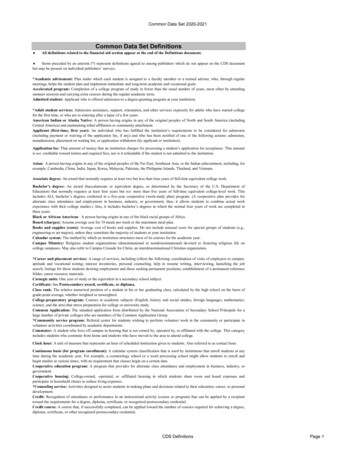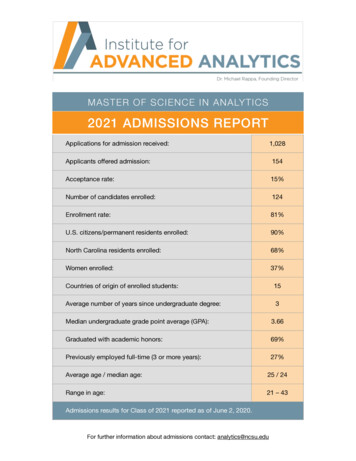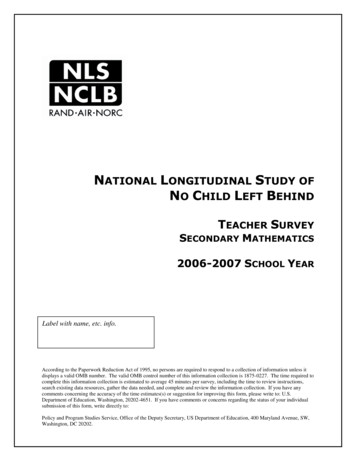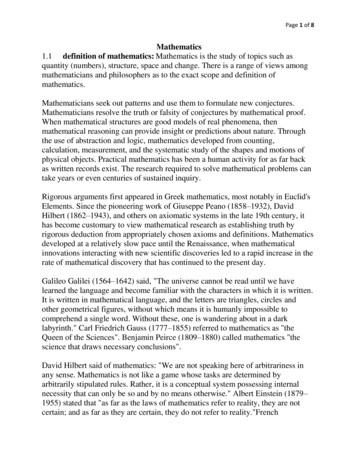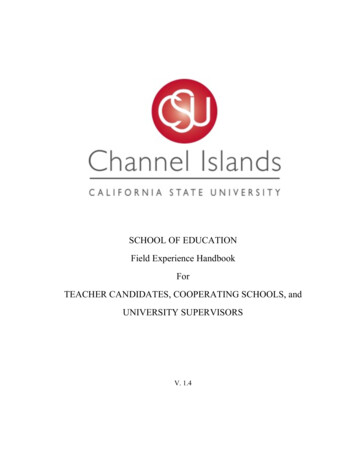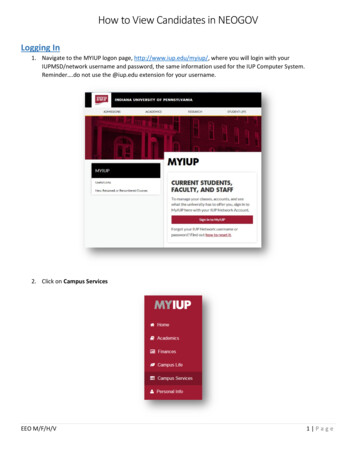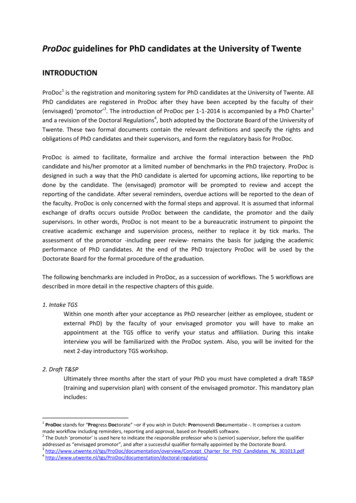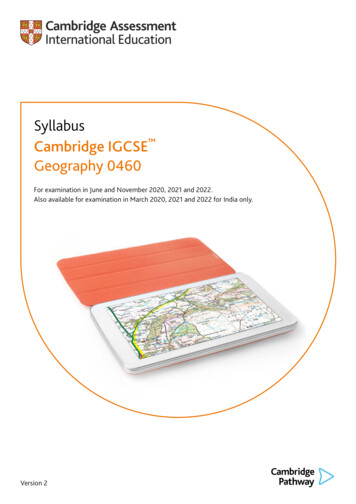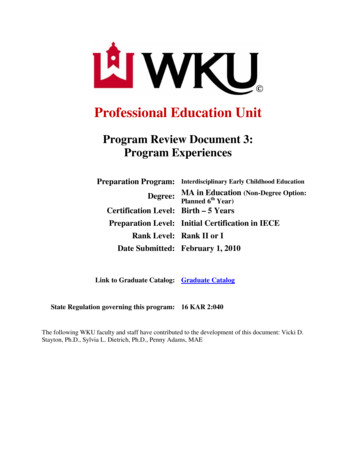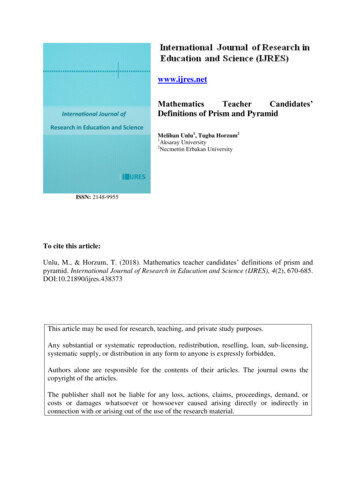
Transcription
tions of Prism and PyramidMelihan Unlu1, Tugba Horzum21Aksaray University2Necmettin Erbakan UniversityISSN: 2148-9955To cite this article:Unlu, M., & Horzum, T. (2018). Mathematics teacher candidates’ definitions of prism andpyramid. International Journal of Research in Education and Science (IJRES), 4(2), 670-685.DOI:10.21890/ijres.438373This article may be used for research, teaching, and private study purposes.Any substantial or systematic reproduction, redistribution, reselling, loan, sub-licensing,systematic supply, or distribution in any form to anyone is expressly forbidden.Authors alone are responsible for the contents of their articles. The journal owns thecopyright of the articles.The publisher shall not be liable for any loss, actions, claims, proceedings, demand, orcosts or damages whatsoever or howsoever caused arising directly or indirectly inconnection with or arising out of the use of the research material.
International Journal of Research in Education and ScienceVolume 4, Issue 2, Summer 2018DOI:10.21890/ijres.438373Mathematics Teacher Candidates’ Definitions of Prism and PyramidMelihan Unlu, Tugba HorzumArticle InfoAbstractArticle HistoryThis study aims to analyze how the Mathematics Teacher Candidates (MTCs)define the “prism” and “pyramid” concepts in geometry. The research wascarried out in 2017-2018 academic year with 92 MTCs. This test consists of 3open-ended questions that MTCs can answer conceptually. The first openended question was as “Define a prism”, the second was as “Define apyramid” and the third was as “Explain the differences between prism andpyramid”. The answers of MTCs were investigated according to correctnessand generalization criteria. After data analysis, semi-structured interviewswere held with 11 MTCs who had ineligible expressions in their definitions.The research revealed that MTCs were unsuccessful in defining prism andpyramid concepts and had difficulties in expressing the differences betweenthese two concepts. Therefore, it was determined that they have insufficientknowledge.Received:24 March 2018Accepted:26 June 2018KeywordsPrismPyramidConcept imageMathematics teachercandidatesGeometry educationIntroductionIn Turkey, “General Proficiencies of Teaching Profession” is prepared by Ministry of National Education andaccording to it, teachers’ proficiencies are handled through pedagogical content knowledge, subject matterknowledge and curriculum knowledge (Ministry of National Education [MoNE], 2017). The works in literatureindicate that teacher’s pedagogical content knowledge has an important influence on students’ learning (Ball,1988; Ball & McDiarmid, 1989). However, it cannot be denied that subject matter knowledge has an importantplace on the formation of pedagogical content knowledge. According to the studies there is a close relationbetween subject matter knowledge and pedagogical content knowledge (Borko, Eisenhart, Brown, Underhill,Jones, & Agard, 1992; Capraro, Capraro, Parker, Kulm & Raulerson, 2005; Even, 1993; Ma, 1999;McDiarmid, Ball & Anderson, 1989; Türnüklü, 2005). So, a good level of subject matter knowledge bothincreases the quality of teaching and contributes the success of students as well (Ball, Thames & Phelps, 2008;Brown & Borko, 1992; Hill, Rowan & Ball, 2005; Ma, 1999). Subject matter knowledge of a teacher especiallybecomes more important in mathematics and geometry which are assumed as difficult by most of the students(National Council of Teachers of Mathematics [NCTM], 2000) and this knowledge has a great importance inteaching mathematics.A deep subject matter knowledge is very important for a mathematics teacher (NCTM, 2000) and a teacher hasto deeply know the subject s/he is going to teach (Türnüklü, 2005). Here what is actually meant by deep subjectmatter knowledge is what a mathematics teacher has to know about the subject matter. The first thing amathematics teacher has to know is basic knowledge. This type of knowledge which is called as profoundunderstanding of fundamental mathematics by Ma (1999) is the subject matter knowledge in a sense that ateacher must have. In the second place when thinking about what mathematics teacher has to know, the teachingprocess comes to mind. Many teaching activities during teaching process such as teacher’s selecting properteaching activities, asking productive questions, evaluating learning of her/his students depend on teachers’having sufficient content knowledge (Ball & McDiarmid, 1990). Besides, the teachers’ deficiencies in subjectmatter knowledge affect students’ learning negatively. For this reason, an effective teaching from a teacher withinsufficient subject matter knowledge cannot be expected. Therefore, it is thought that MTCs who to possesssufficient subject matter knowledge.According to Shulman (1986) mathematical concepts come in the third place for a mathematics teacher to knowbecause the concepts are important components of content knowledge. Teachers have to know perfectly thefundamental characteristics, representations and alternative ways related to concepts on a subject matter. In thiscontext Zazkis and Leikin (2008) indicates that definitions of mathematical concepts, the structures under these
Int J Res Educ Sci671definitions and definition processes are the fundamental components of subject matter knowledge ofmathematics teachers. This means that having this knowledge shapes the subject matter knowledge (Even,1993). However, the researches show that teachers should understand these concepts or processes in order toform correct representations of the concept (Borko et al., 1992; Ma, 1999; McDiarmid et al., 1989). On the otherhand, it is not enough to know the concept and carry on procedural processes. The main purpose is to build abalance between procedural and conceptual knowledge which is a part of subject matter knowledge. For thatreason, conceptual processes should be handled and new approaches should be acquired. With this idea,researchers focused on knowing concept definitions, understanding and forming concepts (Leinhardt & Smith,1985; Shulman, 1986; Vinner, 1991; Vinner & Dreyfus, 1989; Zazkis & Leikin, 2008). In the same scope,definitions of concepts are focused in the current study.Mathematics has its own original concepts as all other disciplines have (Bozkurt & Koç, 2012). Even sublearning area of mathematics such as algebra and geometry are structurally different from each other. Forexample, geometrical concepts are different from other mathematical concepts in three different ways. These arethe images, definitions and peculiarities of a geometric figure (Fischbein, 1993). When the visual images of ageometric figure becoming more prominent than the concept definition (Türnüklü, Alaylı & Akkaş, 2013),students may experience difficulty in understanding the geometrical concept and so, required conceptualizationcannot be provided (Kaplan & Hızarcı, 2005). In order to provide the required and consistent conceptknowledge, richer experiences about the concepts can be provided for students; however, it is not so easy toform a consistent concept knowledge (Tall, 1988), because it is a known fact that same structures are notassociated to a concept in different minds. As Dienes (1971) indicates, each individual may see and understandworld in different ways and may exhibit different approaches. Therefore, individuals’ knowing the conceptdefinitions does not mean they understand the concept (Vinner, 1991). In this scope, it is known that there aredisharmonies between the concepts formulized by mathematicians and the concepts individuals interpret (Tall,1992). The structure of concept image-concept definition of Vinner and Hershkowitz (1980) can be mentionedhere. According to this, the concept definition is defined as a whole of symbols and form of words which areaccepted by mathematicians (Tall & Vinner, 1981).Besides, the definitions which compose the fundamentals of mathematical thinking are very important information of a mathematical concept, in differentiating a concept from other concepts and in expressingmathematical ideas (Çakıroğlu, 2013). However, concept image includes some structures associated with thatconcept in minds of individuals (Tall & Vinner, 1981; Vinner 1991). Although they are assumed as separatefrom each other, there are some relations between concept definition and concept image. For example, conceptimages are formed as the results of individuals’ experiences with concept definitions and samples (Vinner &Dreyfus, 1989). So, these images may improve as cognitive structure improves. Here, formal definitions arestructured by individuals, creating personal definitions that are the foreground of individual aspects of theformal definition. Definitions structured by individuals for a special concept (personal definition), their formalcharacteristic in minds, transmissions and relations among concepts are all important for conceptualunderstanding. Thus, teachers’ knowledge about mathematical definitions are the main components of theircontent knowledge (Leikin & Zazkis, 2010). Because multifaced structures of geometric concepts and contentknowledge of teachers may influence classroom activities, it is important to investigate the content knowledgeof those who teach or will teach geometric concepts. Geometric content knowledge has two fundamentalcharacteristics; the first is to know “what” a concept is and the second is to know “why and how” a concept is so(Tuluk, 2014). For this reason, it is thought that geometric figures and solids among the fundamental concept ofgeometry should be investigated in this scope, because it is a fact that students from preschool education tilluniversity at all levels have difficulties in defining, recognizing and expressing their characteristics of geometricconcepts (Clements & Sarama, 2000; İncikabı & Kılıç, 2013; Tsamir, Trosh & Levenson, 2008; Türnüklü &Ergin, 2016). But unfortunately, it is also known that mathematics teachers and mathematics teacher candidateshave difficulties in recognizing main mathematical and geometric concept, in illustrating the definitions andrecognizing them, and even they have misconceptions (Bozkurt & Koç, 2012; Çakmak, Konyalıoğlu & Işık,2014; Gökbulut & Ubuz, 2013; Gökkurt & Soylu, 2016; Horzum & Ertekin, 2018; Kaplan & Hızarcı, 2005;Leikin & Zaskis, 2010; Tsamir, Tirosh, Levenson, Barkai & Tabach, 2015; Türnüklü et al., 2013). It is wellknown that teachers (Gökkurt & Soylu, 2016; Tekin-Sitrava & Işıksal-Bostan, 2018; Tsamir et al., 2015) andteacher candidates (Alkış-Küçükaydın & Gökbulut, 2013; Altaylı, Konyalıoğlu, Hızarcı & Kaplan, 2014;Bozkurt & Koç, 2012; Çakmak et al., 2014; Çetin, Dane, Okur, Bekdemir, Baş, Kanbolat & Özturan Sağırlı,2012; Gökbulut & Ubuz, 2013; Gökkurt, Şahin, Erdem, Başıbüyük & Soylu, 2015; Gökkurt, Şahin, Soylu &Doğan, 2015; Koçak, Gökkurt-Özdemir & Soylu, 2017; Marchis, 2012; Ubuz & Gökbulut, 2015) havedifficulties with geometric solids especially prism and pyramid concepts.
672Unlu & HorzumPrism is a concept that individuals meet a lot in their daily lives, it has an important place among geometricconcepts (Gökbulut & Ubuz, 2013). However, teacher candidates have difficulties in giving definitions (Bozkurt& Koç, 2012; Ubuz & Gökbulut, 2015; Gökkurt & Soylu, 2016), distinguishing critical characteristics (AlkışKüçükaydın & Gökbulut, 2013; Ubuz & Gökbulut, 2015; Gökkurt & Soylu, 2016) and naming (Çetin et al.2012; Horzum & Ertekin, 2018) according to the researches where their knowledge about prism is investigated.In their studies Bozkurt and Koç (2012) shows that MTCs make mistakes when they give definition for prismconcept. Gökbulut and Ubuz (2013) have found that MTCs do not know necessary and enough logicalprinciples for definition of prism, they cannot choose necessary and sufficient prism characteristics to form adefinition and they cannot distinguish its critical characteristics. Horzum and Ertekin (2018) indicate that MTCscall a square prism which stands on its square surface on a desk as square prism. But they call the same prism arectangular prism when it stands on its rectangle surface. Besides, MTCs have misconceptions about prism(Alkış-Küçükaydın & Gökbulut, 2013; Altaylı et al., 2014). Altaylı and her colleagues (2014) asked MTCswhether the new object is a prism or not when a prism is bended and the results show that 76.6% of MTCsfound out that new figure was a prism even if the angles between the corners were right and 12% of MTCssuggested that the new figure was not a prism if the angle was not right. On the other hand, Çetin and hiscolleagues (2012) has investigated the conceptions of rectangular prisms of MTCs with the help of models andthe results show that they have difficulty in naming the figures in skeleton shape and recognizing thecharacteristics about these models.In addition, although pyramid is a concept with a definition and samples that individuals meet often in theirdaily lives, it is difficult to be perceived (Ubuz & Gökbulut, 2015). In related investigations teacher candidateshave difficulty in giving definitions and distinguishing its critical characteristics. Ubuz and Gökbulut (2015)indicate that teacher candidates have difficulty in giving a mathematical definition about pyramid concept andtheir pyramid drawings are generally limited to prototype samples. Also Altaylı and her colleagues (2014) havefound out that teacher candidates have misconceptions in definitions of prism, pyramid and cone concepts andthey do not know the concepts of truncate cone, truncate pyramid at all. Çakmak and her colleagues (2014) havehandled MTCs’ subject matter knowledge of three dimensional solids (prism, pyramid, cylinder, cone, sphere)conceptually and have investigated three dimensional solids under drawing, defining, sampling, reorganizingand spatial thinking categories. The results show that MTCs have some difficulties in defining and recognizingproblems in their subject matter knowledge about three dimensional solids. While defining them, MTCs made ageneral definition instead of giving a mathematical definition and they gave visual-oriented answer forrecognizing solids’ characteristics. Moreover Marchis (2012) stated that some students can’t recognize basicgeometrical shapes and solids.As a result of literature review, prism and pyramid concepts are so important that it is necessary to investigatethe difficulties about these concepts. The person who will teach these concepts has to learn them perfectly inorder not to cause any misconception or contradiction in terms for learners (Çakmak et al., 2014). Therefore,investigating the differences between prism and pyramid concepts definitions, which is not mentioned in theliterature, and how MTCs define them will reveal their content knowledge on prism and pyramid concepts. It isthought that it is important to know the difference between these two concepts and not to be confused. BecauseMTCs need to know the critical characteristics of the concepts and to think about the definitions so that they candetermine the difference between these two concepts. Therefore trying to determine how the MTCs handle thedifference between these two concepts and how they define these concepts offers a unique advantage to thefield. Besides, knowing MTCs’ ideas about prism and pyramid concepts and the differences between them cangive clues about how they will teach in future.Problem of the ResearchThis study analyses how the mathematics teacher candidates understand the “prism” and “pyramid” concepts ingeometry. Therefore, the following questions are investigated:1. How do MTCs define a prism?2. How do MTCs define a pyramid?3. How do MTCs define the differences between prism and pyramid?
Int J Res Educ Sci673MethodResearch DesignIn the current study, the case study method based on qualitative approach was used. A case study investigates agroup or event deeply (Merriam, 2013). In this research, the case study method was chosen because MTCs’definitions of prism and pyramid was investigated by focusing in depth and the case was the selected group ofMTCs to determine their definitions related to prism and pyramid.ParticipantsCriterion sampling method, which is one of the purposeful sampling methods, was used in the research. In thismethod, researchers choose participants according to specific criterions (Patton, 2002). The acceptable criterionin this research is that MTCs should have taken “Geometry” and “Instructional Technologies and MaterialDesign” courses which were taken for 14 weeks. According to this, MTCs took the Geometry course at theirfirst academic year, and Instructional Technologies and Material Design course at their second academic year.Geometry course includes activities and theories about the line, plane and space in Euclid geometry, angles,triangles and quadrilaterals, circle, solid objects, and geometric place. Instructional Technologies and MaterialDesign course includes activities and theories about learning and teaching technology, teaching tools andmaterials, concept maps, computer based training taking into account the mathematical concepts. The thirdcriterion was that MTCs volunteered to participate the study and their names were not used, but instead S 1, S2,S3, .S92 pseudonyms were used. The reason of choosing this MTCs is the conjecture that they have enoughknowledge as institutional and agreeable with geometry concepts investigated. In this sense, this research wascarried out in 2017-2018 academic year with 92 MTCs, 47 of them were 3rd graders and 45 of them were 4thgraders in mathematics teaching department of a university in Central Anatolian Region in Turkey.Data Collection ToolA test for data collection was developed by the researchers. Test was used to reveal definitions of MTCs aboutprism and pyramid concepts. This test consists of 3 open-ended questions which can be answered conceptuallyby the participants. The questions in this test were checked by an expert with PhD in mathematics education interms of correctness of the language and pedagogical-academic accuracy and then, necessary corrections weremade. So, the first open-ended question became as “Define a prism”, the second became as “Define a pyramid”and the third became as “Explain the differences between prism and pyramid”. After data analysis, semistructured interviews were held with 11 MTCs who were randomly selected or who had ineligible expressions intheir definitions. In the interviews, the question “What did you want to say here? Can you explain?” was askedto MTCs who had ineligible points in their definitions. Besides they were also asked to give examples and drawthree different prisms and pyramids with the questions such as “Can you draw 3 different prisms/pyramids?Which peculiarities make them prisms/pyramids?”In the current study open-ended questions were used as the main source of data to determine participants’definitions of prism and pyramid concepts. The documents obtained from the drawings related to the prism andpyramid concept and semi-structured interviews were used as supporting data. And through this datatriangulation structural validity of the current study was obtained.Data Collection and AnalysisDuring data collection process MTCs were told that this test was not an examination and they were asked togive detailed and clear answers. Besides, there was no time limitation when they were answering. MTCs werealso asked to write their names as they would be interviewed in future. Besides, they were told to use theirknowledge in their minds and they were not allowed to use any sources such as internet, book etc. Before thedata analysis, documents, interview audio records and answers of open-ended questions were numberedseparately for each participant. Thus, the relations between the data (obtained from open-ended questions,documents, interviews) could easily be seen and also reliability and validity of data analysis could be controlled.Besides, definitions of prism and pyramid in literature were investigated and in this direction, criticalcharacteristics of prism and pyramid concepts were determined. The following prism and pyramid definitionswere used in this study. A prism is defined as “a polyhedron with two parallel, congruent polygon bases, and
674Unlu & Horzumlateral faces that are parallelograms” (Schwartzman, 1994, p.172). A pyramid is defined as “a polyhedronobtained by connecting each vertex of a polygon to a single point outside the plane of the polygon; the slopingsides of a pyramid are therefore triangles” (Schwartzman, 1994, p.177). According to this, the criticalcharacteristics for prism were determined as follows; PR1. Identical (two) bases, PR2. Parallel bases, PR3.Polygon bases, PR4. Parallelogram lateral faces. The critical characteristics for pyramid were determined asfollows; PY1. Polygon bases. PY2. Triangular lateral faces, PY3. It has an apex. And also the criticalcharacteristics between prism and pyramid concepts were defined according to the critical characteristics ofthese two concepts. The criterias were determined as follows; a. The number of bases: Pyramid has 1 and prismhas 2 (identical) bases; b. Bases are parallel: Prism has, but there is not for pyramid because it does not have twobases; c. Characteristics of lateral faces: Lateral faces are triangle on pyramid and parallelogram on prism; andd. Existence of an apex: Pyramid has an apex but prism does not have it.The answers of MTCs were investigated according to correctness and generalization criteria (Gökbulut & Ubuz,2013; Ubuz & Gökbulut, 2015; Zaskis & Leikin, 2008) and obtained data were arranged and interpreted inaccordance with the research questions. The categories for defining prism and pyramid were investigatedthrough both correctness and generalization criteria. However, the category of explaining the differencesbetween prism and pyramid was investigated through only correctness criterion. Descriptive analysis wasperformed about definitions and explanations of MTCs. The data were classified as definition having one, a fewor all critical characteristics. And then, they were categorized according to correctness and generalizationcriteria. The contents of these criteria are as the followings:Correctness criterion: In the analysis performed with this criterion which belongs to Zazkis and Leikin (2008).When examining the correctness of the definitions provided by the MTCs, it was distinguished as correctanswer, insufficient answer and wrong answer as in the study of researchers (Gökbulut & Ubuz, 2013; Ubuz &Gökbulut, 2015) for prism, pyramid and difference between these concepts. Then the definitions were classifiedas correct answer that had all critical characteristics and included necessary and sufficient conditions. In thisstudy, the correct answer for the prism that include all critical characterics couldn’t be found. On the other hand,the definition for the pyramid as “three dimensional figure with a base in polygon shape, with triangle lateralfaces whose upper corners unite in one point” was evaluated as the correct answer.Besides the definition handled by MTCs were classified as insufficient answer that had some missing criticalcharacteristics or even non-critical characteristics and included logical structure of necessary but insufficient orsufficient but unnecessary conditions. For example, the definition for prism as “a closed three dimensionalgeometric shape whose base and ceiling (meaning the top base) consist of similar geometric forms and lateralfaces are rectangle” has non-critical characteristics and some missing critical characteristics. So this definitionwas coded as insufficient answer.Lastly in the correctness criterion, the definitions handled by MTCs were classified as wrong answer that haddefinition without any critical characteristics and included logical structure of neither necessary nor sufficientconditions. For example, the definition for pyramid as “three dimensional object having corners” does notinclude any necessary and sufficient conditions.Generalization criterion: When examining the generality of the definitions provided by the MTCs, it wasdistinguished as in some researches like special answer, general answer (Gökbulut & Ubuz, 2013; Ubuz &Gökbulut, 2015; Zaskis & Leikin, 2008) and quasi-special answer (Gökbulut & Ubuz, 2013) for prism, pyramidconcepts. Accordingly, this criterion was used to investigate whether a definition comprises all criticalcharacteristics or it was a general definition comprising all other concepts. The definition with any criticalcharacteristics were classified as “general answer”. The following examples can be given for the generalanswer. For example, the definition for the prism as “three dimensional geometric figure composed of width,depth and height” and the definiton for the pyramid as “three dimensional objects which have height, volume,side, corner” can be any geometric object. Besides, the definitions which define prism/pyramid or comprisesome critical characteristics were classified as “quasi-special answer”. The following examples can be given forthe quasi-special answer. For example, the definiton for prism as “three dimensional geometric figures whosebottom and top bases are same polygons and four lateral faces are rectangle” and the definition for pyramid as“a structure whose bottom base consists of regular quadrilaterals and which has an apex” have some criticalcharacteristics. Lastly all definitions comprising all critical characteristics of prism/pyramid were classified as“special answer”.To achieve the reliability for data analysis coding processes were performed by two researchers separately. Thenthe points of “agreement” and “disagreement” were discussed and necessary changes were made. Then the first
Int J Res Educ Sci675and the second coding results were united and consistency percentage through Miles and Huberman (1994)Realibility Agreement/ (Agreement Disagreement). At the end 88% agreement was achieved. The finalcategorizations were produced by resolving the disagreement through consulting with two researchers who havePhD in mathematics education. In order to increase external reliability of the study, all the processes of the studywere detailed and supported with the quotations of the MTCs. In order to increase internal reliability of thestudy, findings were presented directly without any interpretation.FindingsIn this section, according to the data analysis, the definitions of MTCs were sampled according to determinedcategories and interpreted through frequency table.Definitions of MTCs about Prism ConceptDefining prismThe definitions of MTCs about prism concept were investigated through both correctness and generalizationcriteria. For the correctness criterion, the definitions were classified taking into account the criticalcharacteristics for prism defined as identical two bases (PR1), parallel bases (PR2), polygon bases (PR3), andlastly parallelogram lateral faces (PR4). In this context, prism definitions were classified under the titlesincluding one or more of these critical characteristics (Table 1).Table 1. Definitions about prism conceptCriteriaThemeCorrect answerPR1 PR2 PR3 PR4PR1PR2PR3PR4CorrectnessInsufficient answerPR1 PR2PR1 PR3PR2 PR3PR1 PR4*PR1 PR2 PR3Wrong answerSpecial answerGeneralization Quasi-special answerGeneral 1.0913.041.0945.6554.3545.65*MTCs touch upon the point that lateral faces of a prism are quadrilateral or rectangle.According to correctness criterion in Table 1, it can be seen that none of the MTCs could define prism correctly.However, 54.34% of MTCs mentioned one or a few critical characteristics of prism in their definitions that wereaccepted as insufficient answer. In these definitions, MTCs touched upon “identical bases and rectangular orquadrilateral lateral faces” (13.04%) criterion most. What attracts attention on this theme is that most of theMTCs touched upon lateral faces being rectangle and the rest emphasize the lateral faces being quadrilateral.For example, S55 defined prism as “It is a closed shape whose base (bottom) and ceiling (meaning the top base)have the same polygon and lateral faces are quadrilateral” and S52 defined prism as “It is a closed threedimensional geometric shape whose base and ceiling consist of similar geometric forms and lateral faces arerectangle”. In interview, S52 was asked to give example to represent her prism definition and she drew triangle,square and rectangular right prisms that stood on their bases as shown in Figure 1.Figure 1. Prism drawings of S52
676Unlu & HorzumThe second insufficient answer was the criterion “identical and polygon bases” (11.96%) that MTCs touchedupon. Through this theme some MTCs emphasized that bases were generally polygon but some showed theyhad a limited prism knowledge specifying the bases as regular polygons. For example, S75 indicated that “Prismis a three dimensional figure whose base and ceiling are identical regular polygon”. Third, MTCs were handledequally (7.61%) the citeria “identical bases” and “identical and parallel bases” as the insufficient answer. Forexample, S82 defined prism as “a three dimensional figure whose base and top base have the same shape” andS72 defined it as “objects whose bottom and top bases are parallel and in identical forms”. Fourth, some MTCs(6.52%) emphasized in their prism definitions that only bases are polygon. One of the MTCs, S24, emphasizedthat the bases were polygon on prism with her definition as “an object having polygonal base and ceiling, andheight”. As the fifth insufficient answer, few MTCs (3.26%) mentioned in their definitions that only lateralfaces were parallelogram (especially rectangle). For example, S 32 saying that “a three dimensional figure that
call a square prism which stands on its square surface on a desk as square prism. But they call the same prism a rectangular prism when it stands on its rectangle surface. Besides, MTCs have misconceptions about prism (Alkı-Küçükaydın & Gökbulut, 2013; Altaylı et al., 2014). Altaylı and her colleagues (2014) asked MTCs

